Notre Dame covered the spread while defeating #18 Virginia in a drama free 4th quarter, yet fell in SP+ rating. The Irish havoc rate was outstanding, the offense perfect in the red zone, and the defense limited Bryce Perkins and the Cavs when they had great field position. But the advanced stats see some sustainability questions, and through four games a team still hard to predict week to week.
Something not clear? Check out this handy advanced stats glossary.
No garbage time counted in this contest, as the game stayed within 22 points through the entirety of the fourth quarter.
Explosiveness
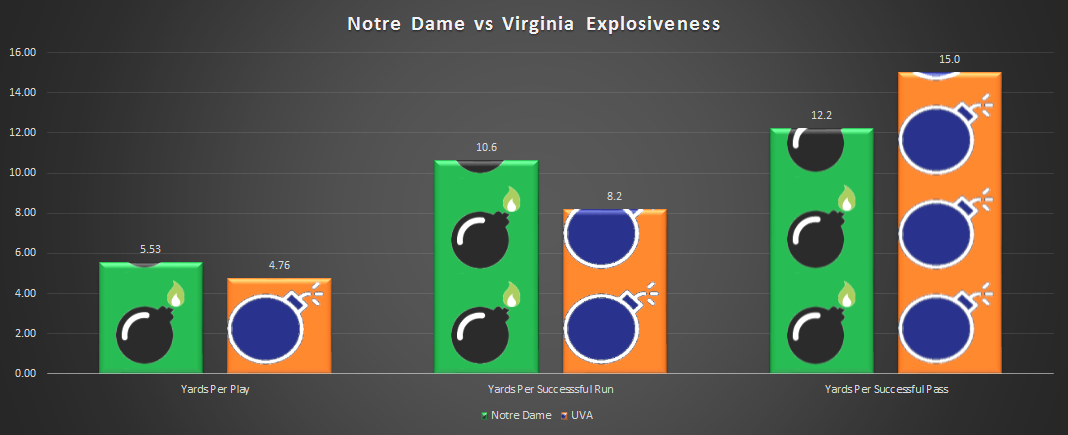
Let’s start with the positives – the Irish outgained a good UVA team by close to a yard per play, capitalizing on advantages in the trenches and scoring opportunities to pull away in the second half. In a game that was flagged preseason as a potential trap and tricky matchup given the strength of Bronco Mendenhall’s defense, that’ll do! There’s certainly been some goal-post moving from “just find a win after Georgia” to “cover the spread” to “win in a way that’s as palatable and confidence-inspiring as possible.”
For a second straight week the run defense clamped down on big plays, this time against a far less talented offensive line and running back, but still crucial given Perkins’ running ability. After red flags were half-raised following some explosive runs given up at Louisville and versus New Mexico, in consecutive weeks against better opponents Clark Lea’s defense has allowed long runs of 16 and 15 yards. The Hoos mustered just six successful runs for the game, and only two gains of 10+.
The passing defense was a different story, especially in the first half. Strategically the ND defense did exactly what seemed to be optimal – limit Perkins in the run game and force third and long situations where Virginia had struggled both this season and last. Unfortunately the Cavaliers receivers and Perkins were excellent in these situations, both executing well and also succeeding in unsustainable ways.
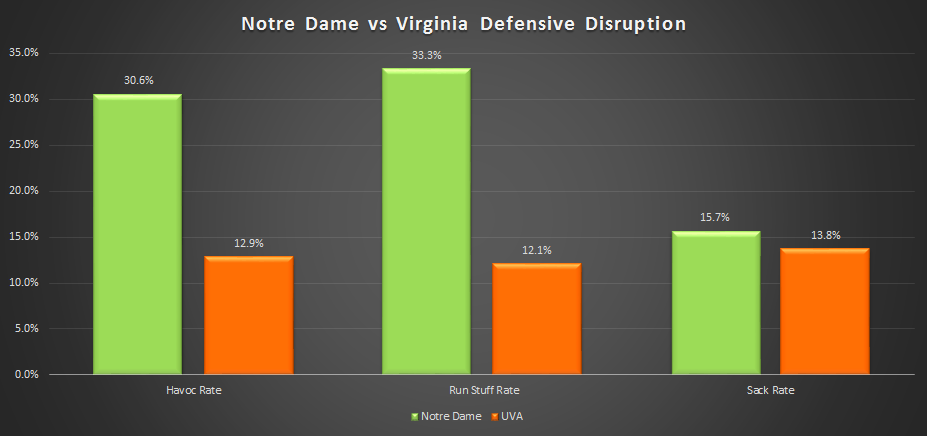
Lea and the defense adjusted in the second half and proceeded to light the box score on fire with an insane 30.6% havoc rate. This was the second highest rate of disruption (havoc is tackles for a loss, including sacks, pass break ups, picks, and forced fumbles) since I’ve started tracking this game to game in 2015, trailing only Stanford last season (an insane 37.3%). The defensive line stuffed one of every three UVA rushes for no gain or a loss, and just for fun piled eight sacks and three forced fumbles on top. For all the rightful attention Kareem, Okwara, and the defensive end rotation have received for their performance, the defensive tackle rotation has been penetrating and closing running lanes impressively.
As Jamie Uyeyama noted on Irish Sports Daily in his rewatch (a weekly post that when added to his film breakdowns is probably the best analysis out there, for those of you that haven’t pulled the trigger), Notre Dame is now up to a 23.1% havoc rate for the year, which would have been 2nd highest in the nation last year (Miami lead FBS with a 24.2% havoc rate).
The long pass plays allowed in the first half could be an opportunity cost of the disruption that’s currently being created, but it may be worth it if it continues to force turnovers and three and outs this frequently. The secondary has rarely allowed open defenders, but sometimes closed a split second too late or been a step behind, so the trade-off could also be less painful moving forward. Also, it’s worth noting that Lea at this point is yet to have an opponent put together four quarters of sustained offense against one of his defenses.
While confidence in the defense continues to grow, the losses of Shaun Crawford and Daelin Hayes are significant setbacks. Crawford was playing outstanding football; thankfully his injury won’t cost him another season, but he’ll miss the two most talented passing attacks left in USC and at Michigan. The immediate adjustment appears to be more time for Jeremiah Owusu-Koramoah in nickel and more snaps for Tariq Bracy, Donte Vaughn, and potentially KJ Wallace (in about that order).
Hayes also had been playing at an extremely high level, and will be missed, but fortunately is at the deepest position group on the team. Kelly confirmed this week that he’ll miss the remainder of the season with a torn labrum, but plans to return for a fifth year. The prospect of the entire DT two-deep returning along with Ade Ogundeji, Hayes, and a whole host of sophomore and freshmen talent is incredibly encouraging for this successful defensive run to continue.
Notes on the #NotreDame offense after re-watching the UVa game | Irish might have found their best 11 to put on the field with 12 personnel, UVa blitzed on 73.5% of plays in the 1st half, and more https://t.co/uKxD9zyvZ7
— Jamie Uyeyama (@jamieuyeyama) September 30, 2019
The offense also deserves a lot of credit for mitigating Virginia’s disruption, as they were aggressive defensively and entered the game among the nation’s leaders in tackles for a loss and sacks. It wasn’t a perfect effort – communication at times left open pass rushers, and Book again showed inconsistency in his response once feeling pressure. But it avoided negative plays and generally kept third downs at manageable distances, with the exception of the continued spread of the false start virus through Jeff Quinn’s meeting room.
Efficiency
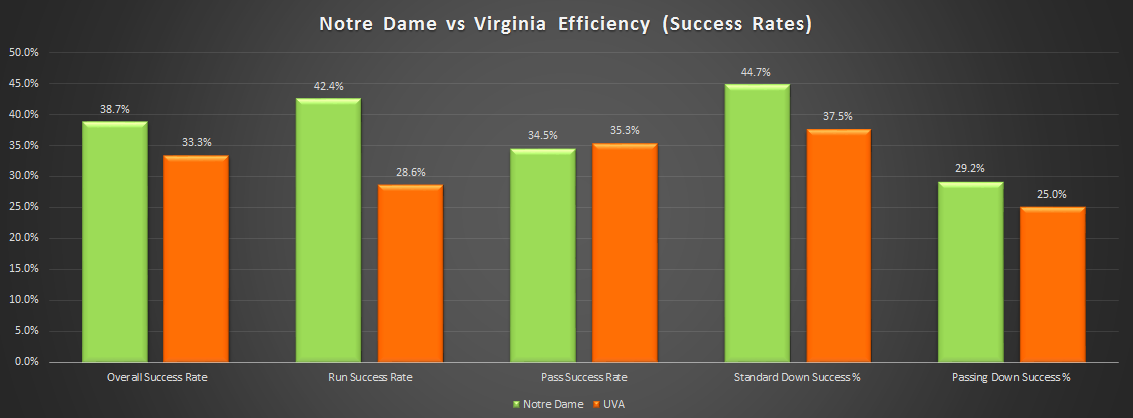
After a fast start for both offenses leading sustained scoring drives in their first few possessions, both teams were very inefficient offensively in the second half. While pass and passing down success rates were nearly identical, the Irish carved out a big advantage with their ability to run the ball at an average rate while the Cavs struggled. Virginia, like the Irish at Georgia the week before, seemed to only halfheartedly run the ball at all, rushing on just 29% of early (1st and 2nd) downs.
The ability to run the ball fairly well against a tough defense was an encouraging sign for an offense that sputtered after its first two drives and still appears in search of an identity. Skill position injuries have repeatedly prevented the discovery of the best personnel groups and sets, and playing what could end up as the two toughest defenses on the schedule back to back doesn’t lend itself to offense explosions.
| Leverage Rate | Average 1st Down Gain | Average 3rd Down Distance | 3rd Down Conversion % | |
| Notre Dame | 61.3% | 5.31 | 6.67 | 40.0% |
| UVA | 66.7% | 3.47 | 8.29 | 28.6% |
Back to some good news – after a very shaky start the year, the offense has now converted its last six third and fourth and short situations, including four for four in power run scenarios against Virginia. The Irish have still been run dominant in these 3rd/4th and two or less situations, with the exception of the late comeback effort in Athens and goal to go situations, which remains puzzling given the success of Ian Book passing in these situations a year ago.
It’s difficult through four games to know what this offense really wants to do. Sometimes Chip Long seems to push the ball downfield or prioritize getting athletes in space with jet sweeps, other times he seems content to try to power his way up the middle. Ian Book as a run threat appears random. Chase Claypool is less efficient than last year, and Chris Finke has just four successful plays in 14 targets. About the most reliable thing so far has been Cole Kmet as a dangerous target down the seam since his return. Tony Jones Jr. had some critical catches on Saturday but in the macro the running backs have failed to provide much of a threat in the pass game with Jafar Armstrong sidelined.
| Player | Targets | Catch Rate | Success Rate | Yards per Catch | Yards per Target |
| Chase Claypool | 37 | 56.8% | 48.6% | 13.62 | 7.73 |
| Cole Kmet | 16 | 81.3% | 62.5% | 13.31 | 10.81 |
| Chris Finke | 14 | 64.3% | 28.6% | 12.56 | 8.07 |
| Lawrence Keys | 11 | 63.6% | 54.5% | 10.00 | 6.36 |
| Tony Jones Jr. | 9 | 66.7% | 33.3% | 6.00 | 4.00 |
| Tommy Tremble | 6 | 83.3% | 83.3% | 19.60 | 16.33 |
The UVA defense is tough, especially in the secondary, but this was Ian Book’s worst regular season game since taking over as full time starter in both passing success rate and yards per attempt. That’s both not a good sign but also a compliment in ways that a no interception, slightly below efficiency game sets a non-Clemson low, but there’s tantalizing room for improvement. Book has taken care of the football, avoiding mistakes and turnovers, but potentially at the cost of downfield opportunities.
Finishing Drives, Field Position, & Turnovers
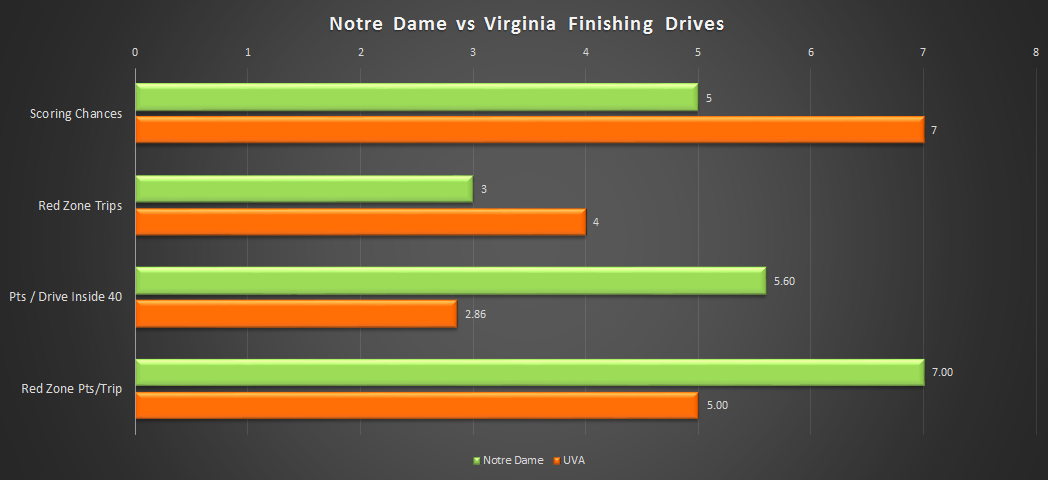
While Notre Dame had decent edges in explosiveness and efficiency, they really opened up the gap in this game thanks to these categories. The Irish had fewer scoring opportunities with first downs inside the opponent 40 than the Cavaliers, but essentially doubled up Virginia in points converted in each visit. (This doesn’t count the final drive for the ND, when time expired with an Irish first down at the UVA 17). The defense weathered the storm of the second half onside kick, the Chris Finke muffed punt, and a Bramblett punt from the end zone that Virginia took over at the Irish 38 yard line.
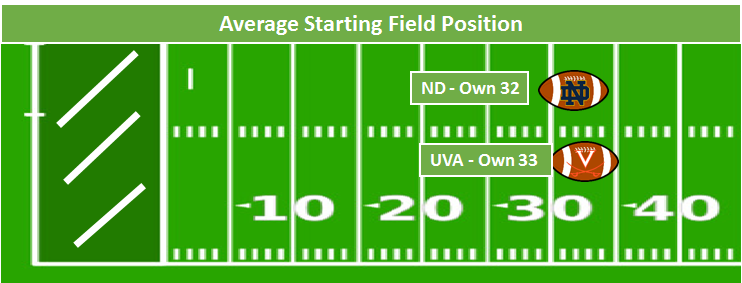
For the first time this season the Irish lost the field position battle, but only by a yard per possession. The 3rd quarter special teams flubs gifted free possessions with great field position, but the Irish countered with forced fumbles and returns that essentially ended in a draw.
The Irish did experience some turnover luck by the numbers in this game, recovering three of five available fumbles. However, this doesn’t account for how and where these forced fumbles took place, as strip sacks are more likely than other fumbles to produce a recovery for the defense.
Through the air Notre Dame also appears a bit luckier than the Cavs, with zero of Book’s passes picked off despite three deflections compared to 2/5 Virginia pass deflections resulting in interceptions. The Irish are now tied for first in turnovers gained per game in FBS, and Per Bill Connelly’s SP+ calculations, this was worth 10.5 points in the game.
This is why despite the big win SP+ dropped Notre Dame in its rankings from 12th to 22nd – the Irish have dominated in categories it views as less stable and less important, and been just ok in creating efficiency and explosiveness advantages against the two ACC opponents played so far.
The temporary upside is that relative to public opinion, SP+ highly values dominating bad opponents. Michigan’s route of Rutgers saw their SP+ ranking jump 4.6 points in total, from 26th to 13th! And with Bowling Green up next, a similarly dominant performance could elevate the Irish back to the edge of the top 10. You can argue the logic of this, but over time and a large sample these type of adjustments have proved to make more accurate predictions over time, and SP+ is currently hitting 58% against the spread in 2019!
A Brian Van Gorder defense, more than anything else, offers an opportunity for the offense to continue to find its identity, get Book comfortable, and gain valuable experience for young skill position players. It feels like late the two tight end sets with Kmet and Tremble may be something that becomes a go-to personnel group with the ability to offer the best run blocking and pass catching threats.
Notre Dame’s run game against Virginia:
Two-tight end sets: 21 carries, 156 yards, 3 TDs, 7.4 YPC
Regular personnel (3 WRs, 1 TE, 1 RB): 12 carries, 34 yards, 1 TD, 2.8 YPC
Impressed by Tommy Tremble’s blocking ability, as well. Offers a flexibility slot receivers do not.
— Pete Sampson (@PeteSampson_) September 30, 2019
As Eric mentioned in his review, the offense is passing a good bit more on early (1st and 2nd) downs – the run rate in these situations has dropped from 52% to about 45% despite running more efficiently in these situations this year (+5.8% in success rate vs. 2018). The passing attack has been more explosive, averaging 8.8 yards per pass play versus 5.5 yards per run, but pass success rate is down 3.2% versus last year on these early down attempts.




There were a couple of points that jumped out to me as being connected. You noted that Finke has not been productive so far this year, and you also noted that the run game was MUCH more productive with a 2 TE alignment. If Finke is not producing in the passing game and is potentially a liability blocking in the run game (running is much better with 2 TEs), is it worth it to be starting him or giving him a lot of the snaps at this point? Yes, wonderful story of walk-on to captain, but the production has not been there (with a muffed punt that was lost too).
Finke has been a big disappointment for sure in terms of production, and I think he’s just not sneaking up on anyone anymore. Defenses know he is a favorite target (probably 3rd now behind Kmet / Claypool, but top 2 befor then) of Book and in short yardage especially.
I wouldn’t give up on him yet, but think the staff has to be looking critically at how he can perform while banged up with this rib injury and in different personnel groups. I think they will still play around with running the ball out of super wide WR splits, sometimes with 3 or 4 WRs. But if this continues there will be tough conversations to be had about snaps between him as a senior captain and a guy like Keys or Young or more 2 TE, any of which can also help more in the blocking game and maybe provide more of a downfield threat.
Really loved Jamie Uyeyama’s article about 12 personnel. I like the idea of that being the developing identity on offense, more of a running to setup the pass, with variations of backs and receivers.
I posted on the other thread about Book’s sharp dropoff in 3rd down completion percentage and efficiency this year. I wonder how much of that pertains to Finke not being as reliable a target. It seems to be a significant factor in our (so far) historically terrible 3rd down conversion rate as a team.
The identity on offense is currently “Quick, give it back to the defense so they can score!”
Tremble’s progression in the blocking department has been one of the bigger surprises to me so far this season. To start the year, he looked completely lost on multiple plays; perhaps he needed a bit of time to get up to the speed of the game. Perhaps he just wasn’t ready to be thrust into Kmet’s role, and had been practicing all offseason for a different job. Whatever the case may be, I love having him on the field now in both passing and running situations. Definitely wouldn’t mind seeing more of him in the slot.
Just go giant with some sets; Kmet, Tremble, Claypool, and McKinley with Jones in the backfield. The collective catch radii would be insane.
This is the Ian Book dream formation. He never has to throw the ball more than 4 yards downfield since none of these guys outside of Claypool have considerable speed.
During the Louisville game he was noticeably blocking so badly that on a to-goal play inside the 5 I told my family that the guy Tremble was blocking would make the tackle. The guy Tremble was blocking made first contact in the backfield and a LB came in to clean it up.
His improvement blocking and the White/Wuuuu improvement at linebacker have been stark and exciting to see. Tremble’s rapid and dramatic improvement makes it a little less depressing that we’re only going to get 10 games of peak-Kmet before he goes pro.